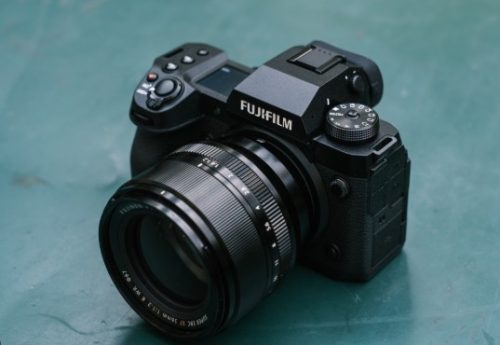Are you a photography enthusiast or professional looking to take your skills a notch higher? If yes, you are in the right place. We understand that the best image stabilization cameras are more than just a tool for your work, and we are going to walk you through the best models for capturing breathtaking images and seamless videos.
The stability provided by modern IS systems makes all the difference between professional-grade shots and a blurry mess. The best image stabilization cameras combine cutting-edge technology and innovation, offering users the ability to shoot with precision and ease. From mirrorless cameras to DSLR options, the market offers a wide range of models designed to suit every need, whether you’re an aspiring filmmaker, a travel photographer, or an avid vlogger.
Types of Image Stabilization Systems in Cameras
Image stabilization systems come in different forms each with its strengths and drawbacks. They include:
1. Optical Image Stabilization (OIS): This is the most common system in cameras. It stabilizes the lens by moving the lens elements to counteract camera shake. Typically, it is found in higher-end lenses and is great for still photography.
2. In-Body Image Stabilization (IBIS): This system uses sensors inside the camera body to compensate for shake, providing stabilization regardless of the lens used. It is ideal for both stills and video.
3. Hybrid Stabilization: Some top-tier cameras combine OIS and IBIS, offering more comprehensive stabilization. Cameras with hybrid image stabilization are ideal for a range of scenarios, especially video work.
4. Electronic Image Stabilization (EIS): Often used in video cameras, this software-based solution crops the image slightly to smooth out shakes. While it is not as effective as OIS or IBIS but works well in certain situations.
Best Image Stabilization Cameras
1. Sony Alpha 9 III Mirrorless Camera
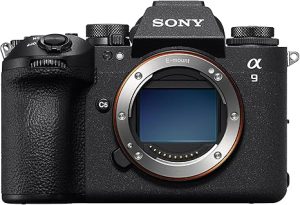
Key Features
- Aspect Ratio: 3:2
- Photo Sensor Technology: BSI CMOS
- Supported File Format: HEIF, JPEG, Raw
- Image Stabilization: Optical
- Optical Zoom: 1.5 x
The Sony Alpha 9 III is the best image stabilization camera. It features the world’s first full-frame image sensor with a global shutter that exposes and reads all pixels simultaneously for capture of fast-moving subjects with absolutely no distortion.
The blackout-free, 120fps continuous shooting is defined by speed and accuracy, enabling it to capture decisive moments with ease. Besides, it’s capable of shooting continuous bursts at up to 120fps with full AF/AE tracking, with no viewfinder blackout, and its AI processor recognizes subjects with astonishingly high reliability.
Another impressive feature of this camera is it preserve split-second moments. At 1/80,000 second maximum shutter speed, the Alpha 9 III makes it easy to capture fast-moving subjects in almost any situation. Furthermore, the compatible flash units can synchronize at all shutter speeds, eliminate drop-off in illumination that occurs with high-speed sync and ensure even illumination.
Well, that’s not all. The Alpha 9 III is equipped with 24.6 million effective pixels, a stacked CMOS architecture and integral memory. This offers high resolution, overwhelming speed, and simultaneous full-pixel readout to help you capture distortion-free images of fast-moving subjects.
Above all, this camera features an evolved BIONZ XR image processing engine with up to eight times more processing power than previous versions.
Pros
- Exceptional at eliminating rolling shutter distortion
- Real-time tracking and eye auto focus
- Excellent build quality
- Flexible and fast storage options.
- Impressive battery life
Cons
- Big budget. Premium features come at a high price
2. Panasonic LUMIX GH6, 25.2MP Mirrorless Micro Four Thirds Camera
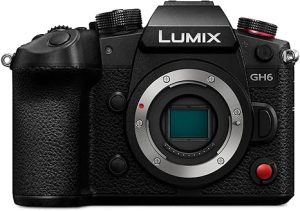
Key Features
- Aspect Ratio: 1.50:1, 16:9, 4:3
- Photo Sensor Technology: MOS
- Supported File Format: MOV
- Image Stabilization Sensor: shift, Dual
- Maximum Focal Length: 140 Millimeters
The Panasonic LUMIX GH6 is a versatile Micro Four Thirds mirrorless camera that caters to both photographers and videographers. Its 25.2-megapixel Live MOS sensor delivers high-resolution images with outstanding detail and clarity.
The highlight of this camera is its Venus Engine processor. It enhances image quality through advanced technologies like Intelligent Detail Processing and 2D Noise Reduction, resulting in natural textures and accurate color reproduction. Furthermore, the GH6 offers a broad ISO range from 100 to 12,800, allowing for flexibility in various lighting conditions.
Regarding image stabilization, the in-body image stabilization (IBIS) system provides up to 7.5 stops of compensation, enabling sharp handheld shots and smooth video footage.
For videographers, the GH6 stands out with its extensive video capabilities. It supports internal recording of 5.7K video at up to 60 frames per second and 4K at up to 120 frames per second. This makes it flexible for high-quality and slow-motion footage. The inclusion of Apple ProRes 422 and 422 HQ recording formats enhances post-production workflows. The camera also features a comprehensive autofocus system with subject detection modes and a robust build for use in various shooting scenarios.
Pros
- Effective in-body image stabilization
- Smooth video footage
- Robust build
- Broad ISO range
Cons
- Its reliance on a contrast-detection autofocus system results in slower performance compared to competitors utilizing phase-detection systems
3. Nikon Z 9 Mirrorless Camera
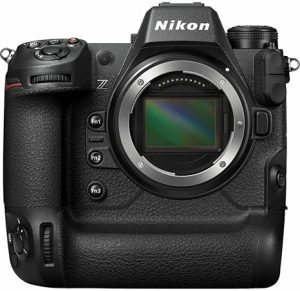
Key Features
- Compatible Mountings: Nikon Z
- Aspect Ratio: 1.50:1, 16:9
- Photo Sensor Technology: CMOS
- Supported File Format: RAW
- Image Stabilization: Dual
- Optical Zoom: 1 x
As one of the best image stabilization cameras, the Nikon Z 9 Mirrorless Camera stands out for its performance and ease of use. It features a fast powerful auto focus that can keep up with the fastest subjects and frame rates. Subject detection uses deep learning to automatically detect and track people, cats, dogs, birds, cars, motorcycles, bicycles, trains and planes in still and video with no menu changes.
Built with the new high-efficiency RAW file format which is 1/3 the size of uncompressed RAW, the camera retains the same high image quality and dynamic range as conventional RAW files. Furthermore, this camera is equipped with a 45.7-megapixel stacked CMOS sensor and the latest EXPEED 7 image processor to deliver exceptional image quality with remarkable detail and dynamic range.
The Z9 supports continuous shooting speeds of up to 20 frames per second in RAW and an impressive 30 frames per second in JPEG. This makes it ideal for sports and wildlife photographers. Besides, the ability to record 8K video at up to 60 frames per second and 4K at up to 120 frames per second offers filmmakers high-resolution and flexible shooting options.
Regarding construction, the camera’s design incorporates a robust, weather-sealed body with an integrated vertical grip for enhanced handling and durability in challenging environments. Its electronic viewfinder provides a clear and responsive display, while the 3.2-inch tilting touchscreen facilitates versatile composition and navigation.
Pros
- Blackout-free electronic viewfinder for real-time shooting
- Industry-leading autofocus with subject recognition for humans, animals, vehicles
- 8K 60p and 4K 120p internal video recording
- Robust, weather-sealed build for professional use
- Excellent battery life for a mirrorless flagship
- Four-axis tilting touchscreen for versatile shooting angles
Cons
- Heavy weight
4. Fujifilm X-H2 Mirrorless Digital Camera
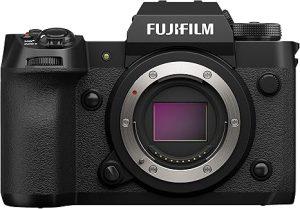
Key Features
- Aspect Ratio: 16:9
- Photo Sensor Technology: BSI CMOS
- Supported File Format: RAW
- Image Stabilization: Sensor-shift
- Expanded ISO Minimum: 125
The Fujifilm X-H2 is a high-resolution APS-C mirrorless camera that combines advanced imaging capabilities with robust video features.
This camera delivers exceptional image quality with impressive detail and dynamic range. It supports an ISO range from 64 to 51,200, allowing for versatile shooting in various lighting conditions. Besides, the in-body image stabilization (IBIS) system provides up to seven stops of compensation, facilitating sharp handheld shots even at slower shutter speeds.
The X-H2’s autofocus system includes 425 phase-detection points and utilizes AI deep learning to detect and track subjects such as animals, birds, and vehicles, enhancing its versatility for different photography genres.
In terms of video capabilities, the X-H2 stands out with its ability to record 8K/30p 10-bit 4:2:2 footage internally. This makes it ideal for professional videographers seeking high-resolution options. This camera also supports Apple ProRes codecs and offers a 4K HQ mode that oversamples 8K footage for superior 4K output.
Pros
- Commendable build quality
- Clear and detailed views
- Ease of use
- AI deep learning
Cons
- Relatively heavier and bulkier compared to some competitors
5. Canon EOS R7 Mirrorless Camera
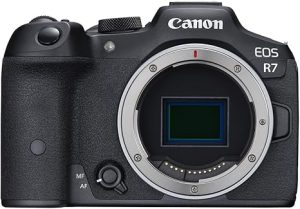
Key Features
- Aspect Ratio 3:2
- Supported File Format: C-RAW, HEIF, JPEG, Raw
- Image Stabilization: Sensor-shift
- Maximum Focal Length: 150 Millimeters
- Maximum Aperture: 6.3 f
Canon is renowned for its premium cameras and the EOS R7 Mirrorless Camera is not any different. It features a 32.5-megapixel APS-C CMOS sensor that’s designed for powerful telephoto reach and fast, continuous shooting with high-speed autofocus.
The highlight of this camera is its advanced autofocus. The dual pixel CMOS AF technology with up to 651 AF zones uses every pixel on the imaging sensor to detect focus, covering approximately 100% width and height. As a result, it enables easy and accurate capturing of crisp, clear images of sports, animals, cars, or life in the moment
With the high-speed shooting, you can capture every split second of the action with 15 fps mechanical shutter, 30 fps electronic shutter and RAW Burst Mode with 1/2-second pre-shooting. Besides, the 5-Axis In-body Image Stabilization System (IBIS) with auto-level technology and coordinated control IS captures shake-free images and video, even in low light conditions.
This camera is video optimized for high-quality video recording. You get professional-grade 4K video on-the-go with Movie Servo AF, an autofocus system that includes subject detection and subject tracking for quicker shooting and a stronger focus.
To top it all off, the compact and lightweight body is made with a comfortable and firm grip for easy handling. It fits conveniently into your camera bag so you can take it with you on all your adventures.
Pros
- Compact and lightweight design
- High-quality video recording
- High-speed shooting
- Advanced autofocus
Cons
- Lacks high dynamic range performance
6. OM SYSTEM Olympus OM-1 Mark II Micro Four Thirds System Camera
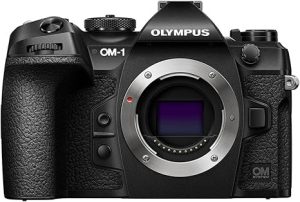
Key Features
- Aspect Ratio: 16:9
- Photo Sensor Technology: Stacked BSI Live MOS sensor
- Supported File Format: RAW, JPEG
- Image Stabilization: 5-Axis
- Maximum Aperture: 2.8 Millimeters
The OM SYSTEM Olympus OM-1 Mark II is a remarkable evolution in the Micro Four Thirds camera lineup. It is designed and built with advanced features to deliver outstanding performance for both professional photographers and enthusiasts.
Building on the success of its predecessor, the OM-1 Mark II features a stacked BSI Live MOS sensor and TruePic X engine that together produce fast readout speeds and exceptional image quality, even in challenging lighting. The autofocus system is vastly improved, offering AI-powered subject detection that locks on to birds, animals, cars, and more with uncanny accuracy.
Furthermore, the burst shooting at up to 120 fps in RAW with full AF/AE tracking makes it a dream for wildlife and sports shooters. The deep integration of computational photography tools like high Res Shot mode, Live ND filters, and Starry Sky AF caters to creative and technical photographers alike, enabling shots that traditionally required bulky gear or lengthy post-processing.
More importantly, the camera body is robust and lightweight, with weather-sealing that ensures confident shooting in rain, snow, or dusty environments. Battery life is also excellent for a mirrorless camera of this class, and the dual SD UHS-II card slots offer flexibility and speed.
Pros
- Rugged build quality
- Highly portable system camera
- Versatile use
- Deep integration of computational photography tools
Cons
- The menu system is refined, though still deep, requiring a bit of a learning curve
7. Nikon Z f Camera with Special Edition Prime Lens
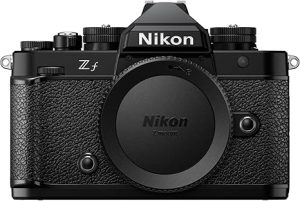
Key Features
- Aspect Ratio 3:2
- Supported File Format: JPEG
- Image Stabilization: Sensor-shift
- Maximum Focal Length: 40 Millimeters
- Optical Zoom: 3
The Nikon Z f Camera with Special Edition Prime Lens is our last recommendation for the best image stabilization cameras. It offers a remarkable fusion of vintage aesthetic and cutting-edge technology to meet the needs of individuals who appreciate both the art and the craft of photography
This camera commands attention with its classic, retro-inspired design reminiscent of Nikon’s iconic film cameras. Beneath the nostalgic exterior lies a thoroughly modern mirrorless powerhouse, driven by the same EXPEED 7 processor. The camera delivers fast and reliable autofocus, excellent in-body image stabilization, and an incredibly sharp 24.5MP full-frame sensor.
Furthermore, the Z f handles each task with precision and elegance, whether you’re shooting in low light, capturing fast-moving subjects, or recording 4K video. It also features tactile controls, including dedicated dials for ISO, shutter speed, and exposure compensation. This makes it a joy to use for photographers who value manual control and a more immersive shooting experience.
The included Special Edition Prime Lens is the perfect companion to this camera, both in performance and style. With its compact size and retro design, it maintains the aesthetic continuity while delivering stellar optical performance. Over and above that, the lens is fast, sharp, and produces beautifully rendered images with excellent contrast and color fidelity.
Pros
- Discreet profile
- Versatile focal length
- Compact size and retro design
- Excellent image quality with impressive dynamic range
- Advanced autofocus system with effective subject tracking
Cons
- Noticeable rolling shutter effect when panning in 4K
How to Choose the Best Image Stabilization Camera
Choosing the best image stabilization camera involves considering several key factors that align with your photography or videography needs. These factors include:
Type of Stabilization Technology
The first thing to consider is the type of stabilization technology the camera uses. Cameras typically offer optical image stabilization (OIS), in-body image stabilization (IBIS), digital stabilization, or a combination of these. IBIS, is more effective as it works across all attached lenses, making it a versatile option for photographers and videographers. Optical stabilization in lenses can also provide excellent results, especially for telephoto or zoom lenses.
Stabilization System Effectiveness
Another important factor is the effectiveness of the stabilization system, often measured in stops of compensation. A camera that can compensate for more stops allows for sharper images at slower shutter speeds, which is particularly useful in low-light conditions or when shooting handheld.
Number of Axes
The number of axes the stabilization system supports—commonly 3-axis, 5-axis, or more—also influences its performance. The best image stabilization camera should have at least 3 axes to compensates for pitch, yaw, roll, and other movements. This is particularly important for handheld shooting, low-light conditions, or when using telephoto lenses.
Intended Use
It is also important to consider the camera’s intended use. If you are a vlogger or videographer, prioritize smooth, gimbal-like video stabilization. On the other hand, wildlife or sports photographers will need stabilization that works well with long focal lengths.
Expandability
The best image stabilization camera should be compatibility with stabilized lenses or accessories that expand its stabilization capabilities. With this expandability, you can use the camera for a wide range of applications.
Size and Ergonomics
Lastly, ergonomics and size influence how practical a stabilized camera is for prolonged use or travel. Balancing all these two elements ensures you choose a camera that not only delivers excellent image stabilization but also fits seamlessly into your workflow.
Read Also
- 7 Best Image Stabilized Binoculars for Boating
- 7 Best Image Stabilized Binoculars for Birding
- 7 Best Binoculars for Seniors
Why is Image Stabilization in Cameras Important?
Image stabilization in cameras is important as it allows for:
-
Sharper handheld shots
-
Slower shutter speeds without motion blur
-
Smoother video recording
-
Better low-light performance without increasing ISO
FAQs
- Does image stabilization work for both photos and videos?
Yes. Image stabilization works for both photos and videos though the effectiveness varies. Video stabilization often combines optical/digital methods and may include software post-processing.
- Is image stabilization necessary if I use a tripod?
No. It is recommend that you turn off IS when using a camera on a tripod as the system might try to “correct” non-existent movement and introduce blur.
- Does image stabilization affect image quality?
No. Optical and IBIS do not degrade image quality. However, digital stabilization can slightly crop the image and reduce quality if not well-implemented.
- Is image stabilization the same across all camera brands?
No, Both performance and effectiveness vary by brand and model.
Final Words
Hopefully, this buying guide on the best image stabilization cameras has steered you in the right direction. By balancing stabilization performance with your budget and shooting style, you will have the confidence to choose a camera that ensures sharp photos and stable, professional-looking videos.

